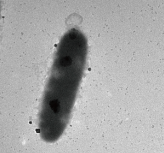Muricauda abyssi
Classification
Bacteria; Bacteroidota; Flavobacteriia; Flavobacteriales; Flavobacteriaceae; Muricauda
Species
Muricauda abyssi
Genus Muricauda
|
NCBI: [1] |
Description and Significance
Muricauda abyssi is a novel, non-motile, rod-shaped gram-negative bacterium isolated in deep seawater from the Marina Trench, the deepest point in the Earth's oceans. (NIH, 2022.) M. abyssi is important to the genus Muricauda by identifying the highest with </>Muricauda oceani at 99.0% and secondly Muricauda Aquimarina with a 97.0-98.8% sequence similarity to M. abyssi allowing for research of relations between closely related type strains in the genus Muricauda (NIH, 2022.) M. abyssi are also important for modulating the process of photosynthesis due to the majority of the genus Muricauda synthesizing Zeaxanthin. (NIH, 2018).
Genome Structure
Muricauda abyssi is designated as strain W52T with the 16S rRNA gene sequences indicating the microbes' relation to the members of the genus Muricauda with the major respiratory quinone being MK-6 demonstrating a biomarker for the bacterial community M. abyssi resides in (NIH, 2022.) The polar lipids in M. abyssi are phosphatidylethanolamine (PE) and there were three unidentified lipids and one unidentified amino lipid with iso-C15 : 0, iso-C17 : 0 3-OH, and iso-C15: 1G as the major fatty acids. (NIH, 2022). The G+C content of the genomic DNA was 41.7%. The makeup of these structures allows for M. abyssi to appear in yellow, circular colonies. This genome sequencing allows for surviving cold temperatures and resisting Ultraviolet Radiation. The genome size of M. abyssi is 4.4 Mb. The total ungapped length 4.4 and the total number of contigs is 111. ContigN50 is 184.3 kk & ContigL50 is 7. Genome coverage js 258.ox.
Cell Structure, Metabolism and Life Cycle
Muricauda abyssi are small gram-negative, rod-shaped bacterium that forms microscopic yellow colonies and synthesizes zeaxanthin, which is a Zanthophyll that modulates the process of photosynthesis if a plant is overexposed to sunlight (NIH, 2018). Zexanthin is a C40xanthophyll carotenoid with the potential to be applied to nutrition and human health. Studies have been done on the Muricauda strains that produce this zeaxanthin as a carotenoid cultured on marine brother. (NIH, 2014.)
Ecology and Pathogenesis
Muricauda abyssi is a marine bacterium found in the deep seawater of the Marina Trench. All members of the Muricauda genus were originally isolated from salty environments including marine snow, hot springs, clouded seawater etc. M. abyssi help to synthesize zeaxanthin which protects nature and plants during photosynthesis from excessive sunlight (NIH, 2018). The strain W52 could grow at 10-47 °C (optimum at 32 °C ), at pH 5.0-8.0 (optimum at 6.0). The 16S rRNA gene sequencing is used in this scenario and often times in multiple scenarios as a tool to identify bacteria at the species level, using this gene sequencing allows microbiologists to differentiate between closely related bacterial species. When an unknown pathogen strain appears in a clinical laboratory, this is the method used for identification, (and was used for M. abyssi .
References
Dong B, Zhu S, Chen T, Ren N, Chen X, Chen Y, Xue Z, Shen X, Huang Y, Yang J, Chen J. Muricauda oceani sp. nov., isolated from the East Pacific Ocean. Int J Syst Evol Microbiol. 2020 Jun;70(6):3839-3844. doi: 10.1099/ijsem.0.004241. PMID: 32496184.
Murillo, A. G., Hu, S., & Fernandez, M. L. (2019). Zeaxanthin: Metabolism, Properties, and Antioxidant Protection of Eyes, Heart, Liver, and Skin. Antioxidants (Basel, Switzerland), 8(9), 390. https://doi.org/10.3390/antiox8090390
Prabhu S, Rekha PD, Arun AB. Zeaxanthin biosynthesis by members of the genus Muricauda. Pol J Microbiol. 2014;63(1):115-9. PMID: 25033672.
Vizzotto, C. S., Lopes, F. A. C., Green, S. J., Steindorff, A. S., Walter, J. M., Thompson, F. L., & Krüger, R. H. (2018). Draft Genome Sequence of Muricauda sp. Strain K001 Isolated from a Marine Cyanobacterial Culture. Genome announcements, 6(22), e00451-18. https://doi.org/10.1128/genomeA.00451-18
Wang D, Wu Y, Liu Y, Liu B, Gao Y, Yang Y, Zhang Y, Liu C, Huo Y, Tang A, Xu Y, Wei Y. Muricauda abyssi sp. nov., a marine bacterium isolated from deep seawater of the Mariana Trench. Int J Syst Evol Microbiol. 2022 Dec;72(12). doi: 10.1099/ijsem.0.005615. PMID: 36748599.
Zheng, Y., & Sun, C. (2019). Draft Genome Sequences of Two Bacterial Strains, Muricauda sp. 72 and NH166, Isolated from the South China Sea and West Pacific Ocean. Microbiology resource announcements, 8(44), e01042-19. https://doi.org/10.1128/MRA.01042-19
Author
Page authored by Trinity Butler, student of Prof. Bradley Tolar at UNC Wilmington.

